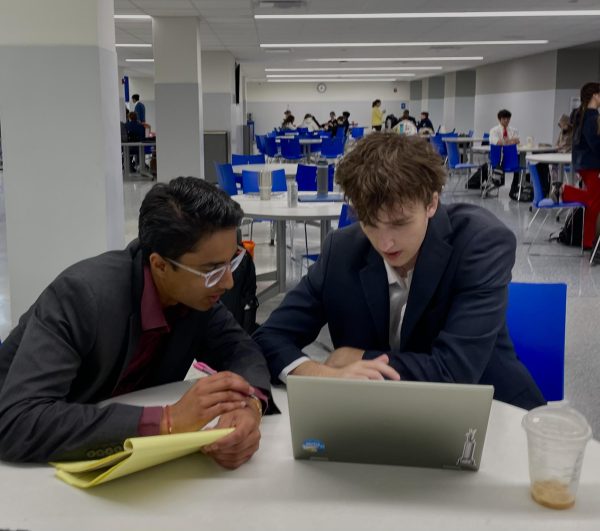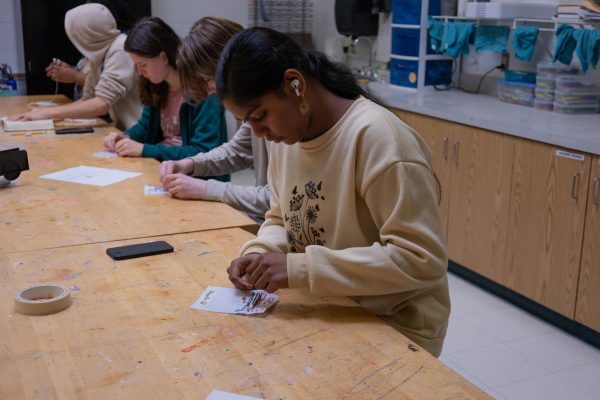Driving Blind
New drivers are increasingly unaware of their surroundings

Many new drivers have discovered that the they were younger, they spent most of their time looking down at electronic devices instead of at their surroundings. This leaves them without a sense of direction when they begin driving on their own.
“So, when you’re on 364 going East, you merge over and exit onto 94. You know, that lane where everyone is merging on and off.”
These are the directions given by a mother to her teenage daughter. However, they are only met by a confused expression.
“You’ll pass where the Stadium 18 Cinema is, and Friday’s.”
The young girl shrugs and shakes her head, signaling to her mother that she hasn’t the slightest clue where the aforementioned buildings were.
“We pass that street where we always turn to meet Grandpa for lunch… ringing any bells?”
“…Nope.”
Becoming a licensed driver is a rite of passage most experience in high school – a freedom that many see as the first step of their transition to adulthood. But for many students today, a bigger challenge stunts their launch into the real world: knowing where to go.
Senior Gabrielle Berger admits she constantly requires the help of her GPS, even when driving along familiar routes.
“[My sense of direction is] not [good] at all. I have to use a GPS to get from [school] to my job, and I work [at least] once a week,” Berger said.
Berger credits some of this to the fact that she does not multitask particularly well.
“No, [I’m not a good multitasker]. I sometimes struggle with walking and talking,” Berger said.
On the contrary, students such as senior Caitlyn Brown, who believe they are able to multitask well, seem to have a better grasp of their surroundings.
“If it’s in the city [I’m good with navigating], but once you cross the river, then I have to use [a gps],” Brown said.
Mobile technology has been on the rise since the 1980s, but now, more than ever, it is readily available to young children and teens.
Former Driver’s Education teacher, Malach Radigan, is fully aware of the impact that having a cell phone readily available is having on new drivers. It seems to affect not only their sense of awareness, but also their overall approach to the task.
“I guess the biggest challenge [for teen drivers] would be cell phones, because when I was driving, I still didn’t have a cell phone. If I did, you only had a certain limit to it,” Mr. Radigan said. “Even teaching kids how to drive today. They’re impatient, and I was probably impatient too, but they’re very impatient. They’re super scared to fail or mess up. And then, even with that, it’s like their attention span is just not there.”
There is a noticeable difference between the directional understanding of teens learning to drive and that of their parents. A portion of this is likely due to the difference in experience while navigating familiar areas.
“My parents are a lot better [with directions]. Just because they’ve lived here for longer, and they know how all the roads [connect], and I haven’t been driving that long,” Brown said.
However, a more problematic factor for the trending disorientation amongst teens is that they were too distracted as children, and paid little to no attention to where their parents were going or how they got there. Brown believes that not paying attention to where her parents were driving in her youth has decreased her understanding of how her surroundings connect.
“ I haven’t paid attention in the car when [my parents] were driving,” Brown said.
Phones aren’t the only source for distraction though. Berger admits that as a child, she paid more attention to books than the passing buildings out of the car window.
“I more [often] read a book, which is still not paying attention,” Berger said.
Even outside of teaching students how to drive, Mr. Radigan has seen how his students act in the car with their parents.
“Just yesterday, leaving school, I was at a stoplight and I saw one of my players in the car with his mom and I mean his headphones are in he’s looking down at his phone,” Radigan said. “So I think that’s probably what it is: is just a distraction piece. If they’re not driving, they’re on their phone or engaged in something else.”
When compared to her brother who often looked around while his parents drove from place to place, Berger has noticed her recognition is much worse.
“I know, my brother, he would refuse to read his book in the car. So he would always look out on the roads and I’d be [reading] a book. And he actually knows where he’s going,” Berger said.
Being detached from everyday tasks such as driving can have a dramatic impact on the efficiency of a person’s life, and can keep us from being present in more places than the road.
“I’ve noticed that sometimes I’ve tried to stop being on my phone when I’m talking to people, but I’ve noticed friends are also on their phone, so it’s like, ‘Oh,’” Berger said. “I realized how much [my phone distracts me] more when I’m trying to actively not be on my phone, if that makes sense.”
Your donation will support the student journalists of Francis Howell Central High School. Your contribution will allow us to purchase equipment and cover our annual website hosting costs. FHCToday.com and our subsequent publications are dedicated to the students by the students. We hope you consider donating to allow us to continue our mission of a connected and well-informed student body.












